2022 MERCEDES-BENZ S CLASS fuel
[x] Cancel search: fuelPage 201 of 610
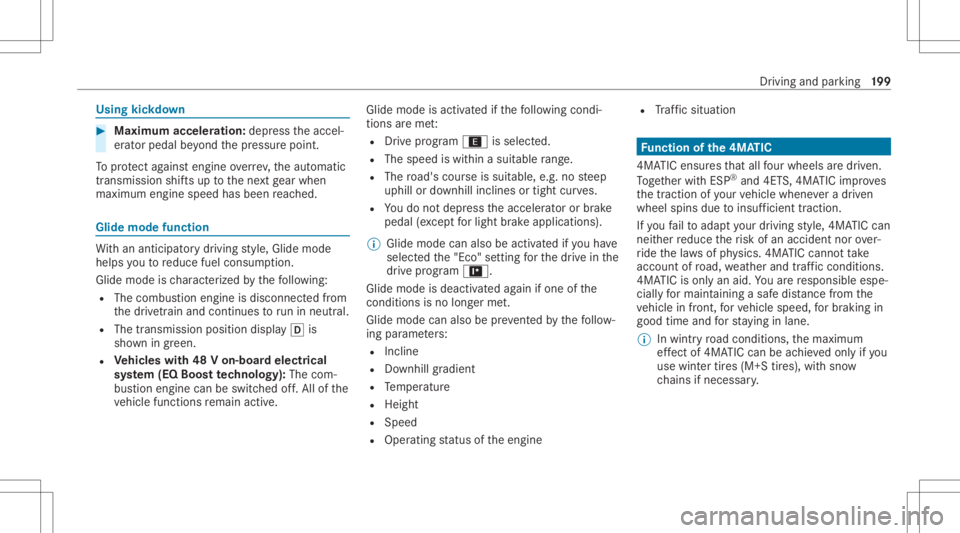
Using
kickdo wn #
Maxim umacceler ation:depresstheaccel‐
er ator pedal beyond thepr essur epoint .
To protect agains tengine overrev ,th eaut omatic
tra nsmiss ionshiftsup tothene xt gear when
max imum enginespee dhas been reac hed. Glid
emod efu ncti on Wi
th an ant icip ator ydr ivin gst yle, Glide mode
helps youto reduce fuelconsum ption.
Glide mode isch aract erize dby thefo llo wing:
R The com bustion engin eis disco nnect edfrom
th edr ivet ra in and continues torunin neu tral .
R The trans mis sion positio ndispl ay005B is
sho wningreen.
R Vehicl eswith 48Von-b oardele ctrical
sy stem (EQ Boos tte ch nology): Thecom‐
bus tion engine canbeswitc hedoff.All ofthe
ve hicle functionsremain active. Gli
de mode isactiv ated ifth efo llo wing condi‐
tion sar eme t:
R Drive pr og ram ; issele cted.
R The speed iswit hin asui table rang e.
R The road's courseissuit able, e.g.no steep
uphill ordownhill inclinesortight curves.
R Youdo notdepr esstheaccelera toror brak e
peda l(e xc ep tfo rlig ht brak eapp lications).
% Glide mode canalsobe activ ated ifyo uha ve
select edthe"Eco" setting forth edr ive in the
dr ive pr og ram =.
Gli de mode isdea ctivated again ifone ofthe
condi tions isno long erme t.
Gl ide mod ecan also be preve nted bythefo llo w‐
ing parame ters:
R Incline
R Downhill gradi ent
R Temp eratur e
R Height
R Speed
R Oper ating status oftheengine R
Traf fic situ ation Fu
nction ofthe4MA TIC
4MA TICensures that all four wheel sar edr iven .
To ge ther wit hES P®
and 4ETS,4MA TICimprove s
th etra ction ofyour vehicle whene vera dr iven
whee lspins duetoinsuf ficie nttracti on.
If yo ufa ilto adap tyo ur drivin gst yle, 4MA TICcan
neit her reduce therisk ofan accident norover‐
ri de thelaws ofphysics. 4MA TICcannotta ke
acc oun tof road, weather and traf fic condi tions.
4MA TICisonly anaid. Youar ere sponsible espe‐
cially formaint ainingasaf edis tance from the
ve hicle infront, forve hicle speed, forbr aking in
good timeandforst ay ing inlane.
% Inwint ryroad con dition s,themaximum
ef fect of 4MA TICcan beachie vedonl yif yo u
use wint ertires (M+ Stir es), withsn ow
ch ains ifnec essar y. Dr
iving and parking 19
9
Page 202 of 610
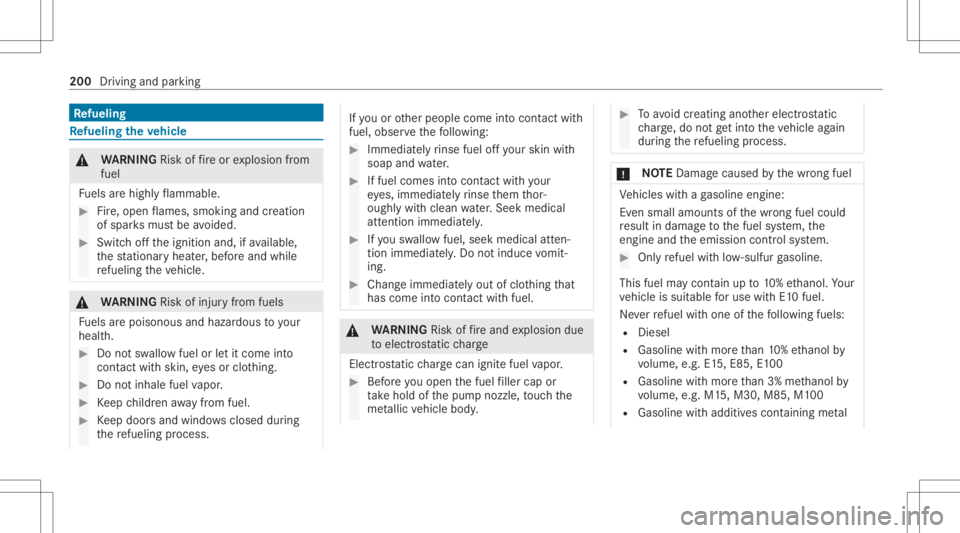
Re
fueli ng Re
fueli ngtheve hicl e &
WARNIN GRisk offire or explosion from
fuel
Fu els arehighly flammab le. #
Fire,open flames ,smo kingand creat ion
of spar ksmus tbe avo ided. #
Swit choffth eignition and,ifav ailable,
th est atio naryheat er,bef oreand while
re fuel ingtheve hicle. &
WARNIN GRisk ofinju ryfrom fuels
Fu els arepoisonous andhazar dous toyour
healt h. #
Donotsw allo wfuel orletit co me into
co ntact withsk in, eyes orclo thing. #
Donotinhale fuelvapor . #
Keep childr enaway from fuel. #
Keep door sand windo wsclos edduring
th ere fuel ingprocess. If
yo uor other people comeintocont actwith
fuel, obser vethefo llo wing: #
Imm ediat elyrinse fuelof fyo ur skin wit h
soap andwater. #
Iffuel comes intocont actwithyo ur
ey es, immediat elyrinse them thor‐
oughl ywit hclean water.Seek medical
att entio nimm ediately . #
Ifyo usw allo wfuel, seek medicalatten‐
tio nimm ediat ely. Do notind uce vomit‐
ing. #
Cha ngeimmedi ately out ofclo thing that
has com eint ocon tact with fuel . &
WARNIN GRisk offire and explosion due
to electr ostatic charge
Ele ctrostatic charge can ignitefuel vapor . #
Beforeyo uopen thefuel filler cap or
ta ke hold ofthepum pnoz zle, touc hth e
me tallic vehicle body. #
Toavo idcreatin gano ther electr ostatic
ch arge ,do notget intoth eve hicle again
dur ing there fuel ingprocess. *
NO
TEDama gecau sed bythewr ong fuel Ve
hicles withaga soline engine:
Ev en small amounts ofthewr ong fuelcould
re sult indamag eto thefuel system, the
engine andtheemission control system. #
Onlyre fuel withlow- sulfur gasoline.
This fuelmaycont ainupto10%ethanol. Your
ve hicle issuit able foruse withE1 0fuel .
Ne verre fuel withone ofthefo llo wing fuels:
R Dies el
R Gasoline withmor eth an 10%ethanol by
vo lume, e.g.E15, E8 5,E100
R Gasoline withmor eth an 3% methano lby
vo lume, e.g.M15,M30 ,M85 ,M1 00
R Gasoline withadditiv escon tainin gme tal 200
Driving andparking
Page 203 of 610
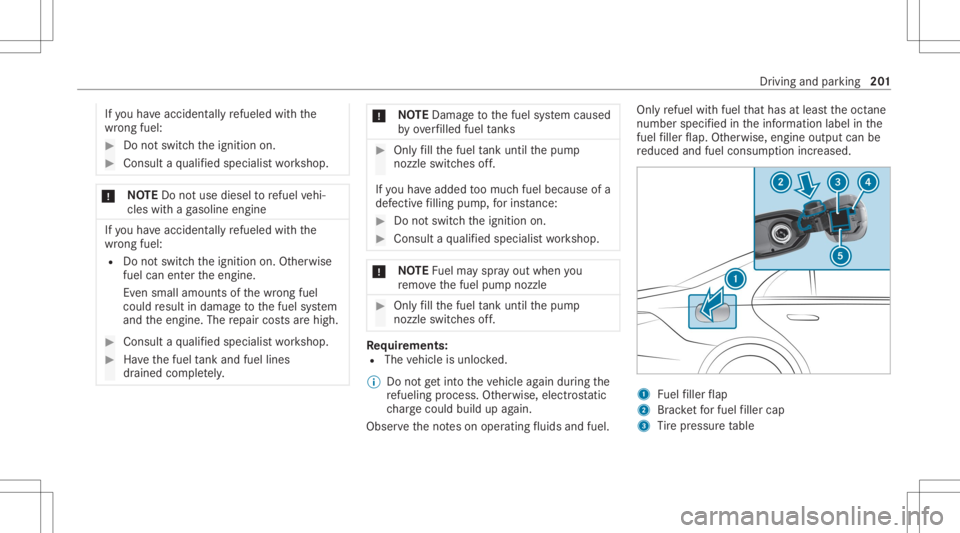
If
yo uha ve acc iden tally re fuel edwithth e
wr ong fuel: #
Donotswit chtheignition on. #
Consult aqu alif ied spec ialistwo rkshop. *
NO
TEDo notus ediese lto refuel vehi‐
cles withaga soline engine If
yo uha ve acc iden tally re fuel edwithth e
wr ong fuel:
R Donotswit chtheignition on.Other wise
fuel canentertheengine.
Ev en small amounts ofthewr ong fuel
could result indamag eto thefuel system
and theengine. Therepair costsarehigh. #
Consult aqu alif ied spec ialistwo rkshop. #
Have thefuel tank and fuellines
dr ained complet ely . *
NO
TEDama getothefuel system caused
by ove rfilled fueltank s #
Only fill th efuel tank unti lth epum p
noz zleswitc hesoff.
If yo uha ve added toomuc hfuel because ofa
def ectiv efilling pump,forins tan ce: #
Donotswi tchth eignition on. #
Consult aqu alif ied spec ialistwo rkshop. *
NO
TEFuelma yspr ayout when you
re mo vethefuel pum pnoz zle #
Onlyfill th efuel tank unti lth epum p
noz zleswitc hesoff. Re
quirement s:
R The vehicle isunloc ked.
% Donotge tint oth eve hicle again during the
re fuel ingprocess. Other wise,ele ctrostatic
ch arge cou ldbu ild up again.
Obs erve theno teson oper ating fluids andfuel. On
lyrefuel withfuel that has atleas tth eoct ane
number specifiedintheinf ormation labelinthe
fuel filler flap. Other wise, engineoutput can be
re duced andfuel consum ption increased. 1
Fuelfiller flap
2 Brac ketfo rfuel filler cap
3 Tire pressur eta ble Dr
iving andparking 20
1
Page 204 of 610

4
QRcode forre scue card
5 Fueltype #
Press onthebac kar ea offuel filler flap 1. #
Turn thefuel filler cap coun ter-cloc kwiseand
re mo veit. #
Insertfuel filler cap from aboveintobr ac ket
2 . #
Com pletely inse rtthepum pnoz zleintoth e
ta nk filler neck,hook inplace andrefuel . #
Onlyfill th efuel tank unti lth epum pnoz zle
switc hesoff. #
Replace thecap onthefiller neckand turn
cloc kwise untilit eng ages audibl y. #
Close fuelfiller flap 1. Pa
rking Pa
rking theve hicl e &
WARNIN GRisk ofacci dent andinjury
cau sed byan insufficie ntlysecu redve hi‐
cle rolling away
If th eve hicle isno tsecur elyparkedsuf fi‐
cie ntly ,it can rollaw ay inan unc ontrolled
wa yev en ataslight downhill gradient. #
Onuphill ordownhill gradients, turnth e
fr ont whee lsso that theve hicle rolls
to wa rdsth ecurb ifit star ts mo ving. #
App lythepar king brak e. #
Switc hth etra nsmiss iontoposition 005D. &
WARNIN GRisk offire cau sed byhot
ex haus tsy stem parts
Flammable materials suchas lea ves, grass or
twigs mayignit e. #
Park theve hicle sothat no flammab le
mat erial can com eint ocon tact with hot
ve hicle component s. #
Inpar ticular ,do notpar kon drygr ass‐
land orhar vested grain fields. &
WARNIN GRisk ofacci dent andinjury
due tochildr enleftunat tende din the
ve hicle
If ch ildr enarelef tunsuper visedintheve hi‐
cle, they cou ld,in pa rticular :
R open doors,ther eb yendang ering other
per sons orroad user s.
R getou tand bestru ck byoncom ingtraf‐
fi c.
R ope rate vehicle equipment andbecome
tr apped, forex am ple.
In addit ion,th ech ildr encould alsosetth e
ve hicle inmo tion, forex am ple by:
R releasing thepar king brak e.
R chang ingthetra nsmiss ionposition .
R star tin gth eve hicle. #
Neverlea vechildr enunat tende din the
ve hicle. 202
Driving andparking
Page 220 of 610

Micr
osleep detection also doe sno tfuncti on
whe nth edr iver camer acann otdetect thedr iv‐
er's eyes, forex am ple asare sult ofthefo llo wing
fa ct or s:
R The driver's eyes areco vereddue tothe
st eer ing column position ,fo rex am ple.
R Poor ambient light.
R Some typesofeyeg lasses orsung lasses.
R The driver's lineofvision isoutside thedr iver
camer a'sfield ofvision.
Also obser veanyinf ormat ionrega rding displa y
mess ages that can bedispla yedon thedr iver
displa y.
The tiredness andalertness assessment of
AT TENTION ASSISTwit hmicr osleep detection is
re se tand restar tedwhen continuing thejour ney
in thefo llo wing situat ions:
R Ifyo uswit choffth eengine.
R Ifyo uunf astenyo ur seat beltandopen the
dr iver's door (e.g.tochang edr iver sor take a
br eak). Ac
tiv eDi stance AssistDI ST RO NIC Fu
nction ofActiv eDi stance Assist
DI ST RO NIC
Ac tiveDis tance AssistDIS TRONI Cma intains the
se tspeed onfree-f lowing roads. Ifve hicles in
fr ont arede tected, these tdis tance isma in‐
ta ined, ifnec essar y,unt ilth eve hicle comes toa
halt. Thevehicle acceler ates orbrak es depend‐
ing onthedis tance totheve hicle infront and
th ese tspeed. Thespeed anddistance tothe
ve hicle infront arese tand save dusing the
st eer ing wheel.
Ac tiveDis tance AssistDIS TRONI Cis available in
th e15 mp h(20 km/h) to130mp h(210 km/h)
spe edrang e.
Ot her featur esofActiveDis tance Assist
DIS TRONI C:
R Adjus tsthedr iving style depending onthe
select eddrive pr ogr am (fuel-sa ving,comfort‐
able ordynamic) (/page19 3)
R Initia tesacceler ationtothestor ed speed if
th etur nsignal indicat orisswitc hedonto
ch ang eto theov ertaking lane R
React sto statio naryve hicles detected in
urb anspe edrang es (exc ep tbicy cles and
mo torcyc les)
R Take sone-sided overtak ing restrictions into
acco untonhighwaysor on multi-lane roads
wit hseparat ero adw ays(countr y-dependen t)
Ad diti onalfunc tionav ailab lein certain coun‐
tr ies :if Ac tiveDis tance AssistDIS TRONI Cha s
br ak ed theve hicle toast ands till,it can automat ‐
icall yfo llo wtheve hicle infront when driving off
ag ain within 30seconds. Ifacr itical situation is
de tected inthesur round ingarea when drivin g
of f,suc has aper son intheve hicle path,avisual
and acous ticwarning isgiv en indic atingth at the
dr iver mus tno wtake contr olof theve hicle. The
ve hicle isno tacceler ated anyfur ther.
Ac tiveDis tance AssistDIS TRONI Cis ready to
pull away when thegr een ç vehicle symbol
fl ashes cyclic ally.
Obser vetheno teson driving systems andyour
re sponsibili ty;yo uma yot her wise failto recog‐
nize dangers(/ page 210). 21
8
Driving and parking
Page 251 of 610
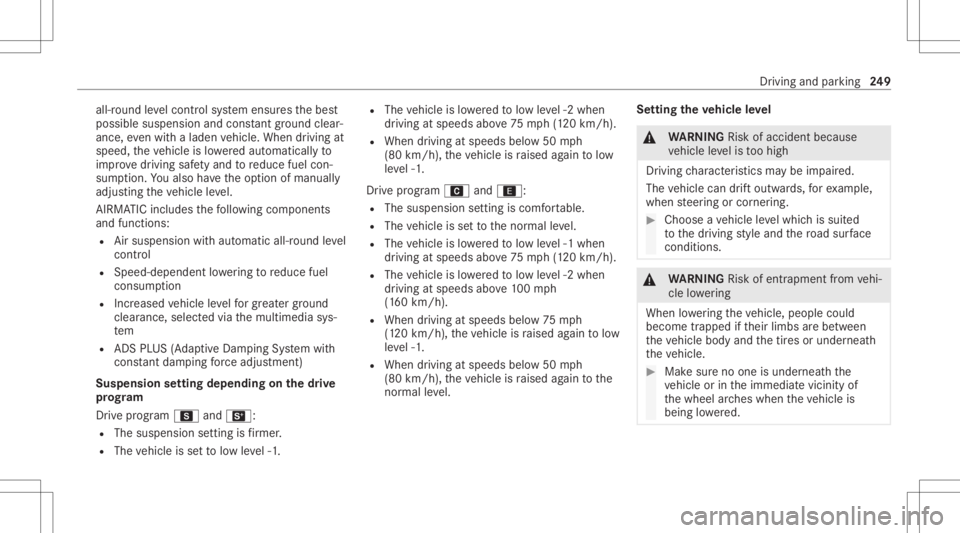
all-r
oundleve lcon trol system ensur esthebes t
possible suspension andconstant groun dcle ar‐
anc e,eve nwi th aladen vehicle. When driving at
speed, theve hicle islowe redaut omatic allyto
im prov edr iving safetyand toreduce fuelcon‐
sum ption. Youalso have theop tion ofmanuall y
adjus tingtheve hicle leve l.
AI RMA TICincludes thefo llo wing compone nts
and func tions:
R Airsuspen sionwithaut omat icall-r ound leve l
contr ol
R Spee d-depend entlowe ring toreduce fuel
con sum ption
R Increased vehicle leve lfo rgr eat erground
clea rance, select edvia themultimedia sys‐
te m
R ADS PLUS (Ada ptive Dam ping System with
con stant dam pingfo rc eadjus tment)
Suspension setting depend ingonthedr ive
pr og ram
Dr ive pr ogr am C andB:
R The susp ens ion se tting isfirm er.
R The vehicle issetto low leve l-1 . R
The vehicle islowe redto low leve l-2 when
dr ivin gat speeds above75 mph(120 km/h).
R When driving atspeeds below50 mph
(80 km/ h),theve hicle israised again tolow
le ve l-1 .
Dr ive pr ogr am A and;:
R The suspen sionsetting iscom fortable.
R The vehicle issetto thenor mal leve l.
R The vehicle islowe redto low leve l-1 when
dr ivin gat speeds above75 mph(120 km/h) .
R The vehicle islowe redto low leve l-2 when
dr ivin gat speeds above100mp h
(1 60 km/ h).
R When driving atspeeds below75 mph
(1 20 km/ h),theve hicle israised again tolow
le ve l-1 .
R When drivin gat speeds below50 mph
(80 km/ h),theve hicle israised again tothe
nor malle ve l. Se
tting theve hicl eleve l &
WARNIN GRisk ofacci dent because
ve hicle leve lis toohigh
Dr iving charact eristic sma ybe impair ed.
The vehicle candrift outw ards, forex am ple,
when steer ing orcor ner ing. #
Choose ave hicle leve lwhic his suit ed
to thedr iving style and thero ad sur face
condi tions. &
WARNIN GRisk ofentr apment from vehi‐
cle lowe ring
Whe nlowe ring theve hicle, people could
become trapped ifth eir limbs arebe tween
th eve hicle body andthetir es orunder neath
th eve hicle. #
Mak esur eno one isunder neathth e
ve hicle orintheimmediat evicin ityof
th ewheel arch es when theve hicle is
being lowe red. Dr
iving andparking24
9
Page 253 of 610
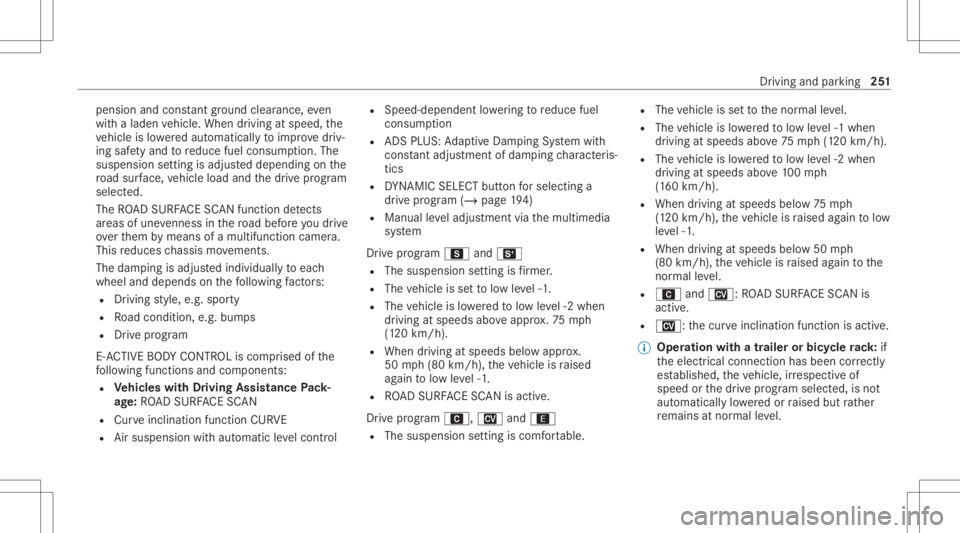
pension
andconstant groun dcle aranc e,eve n
wit haladen vehicle. When driving atspeed, the
ve hicle islowe redaut omatic allytoimprove driv‐
ing safetyand toreduce fuelconsum ption. The
suspen sionsetting isadjus teddependin gon the
ro ad sur face, vehicle loadandthedr ive pr ogr am
select ed.
The ROAD SUR FACE SCAN function detects
ar ea sof une venness inthero ad bef oreyo udr ive
ove rth em bymeans ofamultifu nctioncamera.
This reduces chassis movements.
The dam ping isadju sted individually toeac h
wheel anddepends onthefo llo wing fact or s:
R Driving style, e.g. spor ty
R Road con dition ,e.g .bum ps
R Drive pr ogram
E- AC TIVE BODY CONTR OLiscom prised ofthe
fo llo wing functionsand compone nts:
R Vehicl eswith Drivin gAss istanc ePa ck‐
ag e:RO AD SUR FACE SCAN
R Cur veinc linat ionfunc tion CURVE
R Airsuspen sionwithaut omat icleve lcon trol R
Speed -dependentlo we ring toreduce fuel
con sum ption
R ADSPL US: AdaptiveDam pingSy stem with
con stant adjus tment ofdam pingch aract eris‐
tic s
R DYNA MIC SELE CTbutt onforsele cting a
dr ive pr ogr am (/ page19 4)
R Manua lle ve ladjus tment viathemultimedia
sy stem
Dr ive pr og ram C andB
R The susp ension setting isfirm er.
R The vehicle issetto low leve l-1 .
R The vehicle islowe redto low leve l-2 when
dr ivin gat speeds aboveappr ox.75 mph
(1 20 km/ h).
R When driving atspeeds belowappr ox.
50 mph(80 km/h), theve hicle israised
ag ain tolow leve l-1 .
R ROAD SUR FACE SCAN isact ive.
Dr ive pr og ram A, Nand;
R The susp ension setting iscomf ortable. R
The vehicle issetto thenor mal leve l.
R The vehicle islowe redto low leve l-1 when
dr ivin gat speeds above75 mph(120 km/h).
R The vehicle islowe redto low leve l-2 when
dr ivin gat speeds above100mp h
(1 60 km/ h).
R When driving atspeeds below75 mph
(1 20 km/ h),theve hicle israised again tolow
le ve l-1 .
R When drivin gat speeds below50 mph
(80 km/ h),theve hicle israised again tothe
nor malle ve l.
R A andN: ROAD SUR FACE SCAN is
act ive.
R N: thecur veinc linat ionfunc tion isact ive.
% Oper ation withatrailer orbicy clerack :if
th eelectr icalconnect ionhas been correctly
es tablished, theve hicle, irre spectiv eof
speed orthedr ive pr og ram sele cted, isno t
au tomatical lylowe redor raised butrath er
re mains atnor mal leve l. Dr
ivin gand parking 25
1
Page 274 of 610

No
teson thedr iver disp lay &
WARNIN GRisk ofacci dent dueto a
dr iver displa ymalfunc tion
If th edr iver displa yhas failed ormalfun c‐
tion ed,thefunc tion restrictions applying to
saf etyre leva nt systems areno tvisible.
The oper ating safetyof your vehicle maybe
im pair ed. #
Drive on car efull y. #
Have theve hicle checkedimmediat ely
at aqu alif ied spec ialistwo rkshop. If
th eoper ating safetyof your vehicle is
im pair ed,parkth eve hicle immediat elyand
saf ely. Con tact aqu alif ied spec ialistwo rkshop.
The driver displa ysho wsbasic information such
as speed, enginespeed, fuelleve land coolan t
te mp eratur e.
Ad dition alfunc tionsav ailable toyouinc lude the
fo llo wing:
R Differe nt menu s,e.g .fo rassi stanc eand navi‐
ga tio n R
Status displa ysforth edr iving systems
R Displa ymessag es
R Indic ator and warning lam ps
R Informatio non Consum ptionandrang e
The menu contents andsettings canbeindividu ‐
al ly ad jus tedand set. No
teson the3D driver disp lay
The 3Ddriver displa yenabl esaspat ialrepr esen‐
ta tio nof thecon tent ofthedr iver displa y.Itis a
pr ereq uisi tethat thedr iver be recor ded bythe
dr iver camera .
Sy stem limit s
The system maybe impair edorma yno tfunc tion
in thefo llo wing situat ions:
R The driver camera isdeact ivat ed orisno t
wo rking.
R The driver isouts idethede tection rang eof
th edr iver camer a. R
The oper ating conditions areno tin place,
e.g. ifth eoutside temp eratur eis toolow or
to ohigh. Oper
ating thedr iver disp lay &
WARNIN GRisk ofdist ra ction from infor‐
mati onsystems andcomm unication s
eq uipment
If yo uoperat einf ormat ionand comm unic a‐
tio neq uipme ntintegrat edintheve hicle
when driving, youwill bedistract edfrom the
tr af fic situ ation. Thiscou ldalso cau seyouto
lose control of theve hicle. #
Onlyoper ateth is eq uipmen twhen the
tr af fic situ ation per mits. #
Ifyo ucan notbe sur eof this, stop the
ve hicle whilstpa ying attention toroad
and traffic condi tions andoperate the
eq uipment withth eve hicle statio nary. Obser
vetheleg alrequ iremen tsforth ecount ry
in whic hyo uar ecur rently drivi ng when operat‐
ing thedr iver displa y. 27
2
Driver disp lay